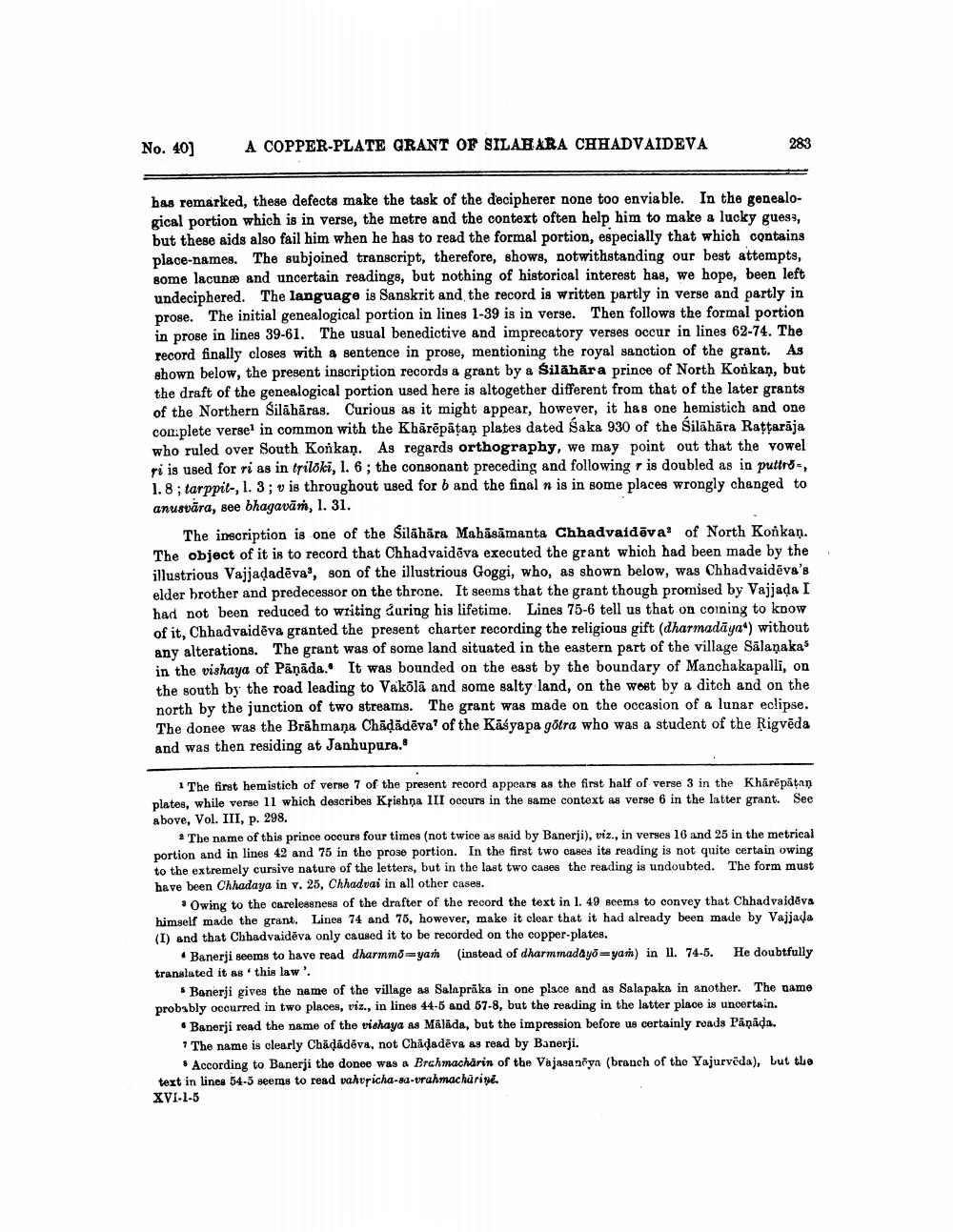________________
No. 40]
A COPPER-PLATE GRANT OF SILAB ARA CHHADVAIDEVA
283
has remarked, these defects make the task of the decipherer none too enviable. In the genealogical portion which is in verse, the metre and the context often help him to make a lucky guess, but these aids also fail him when he has to read the formal portion, especially that which contains place-names. The subjoined transcript, therefore, shows, notwithstanding our best attempts, some lacuna and uncertain readings, but nothing of historical interest has, we hope, been left undeciphered. The language is Sanskrit and the record is written partly in verse and partly in prose. The initial genealogical portion in lines 1-39 is in verse. Then follows the formal portion in prose in lines 39-61. The usual benedictive and imprecatory verses occur in lines 62-74. The record finally closes with a sentence in prose, mentioning the royal sanction of the grant. As shown below, the present inscription records a grant by a Silähāra prince of North Konkan, but the draft of the genealogical portion used here is altogether different from that of the later grants of the Northern Silāhāras. Curious as it might appear, however, it has one hemistich and one complete verse in common with the Khārēpātan plates dated Saka 930 of the Silāhāra Rattarāja who ruled over South Konkan. As regards orthography, we may point out that the vowel ri is used for ri as in triloki, 1. 6; the consonant preceding and following ris doubled as in puttro, 1.8; tarppit-, 1. 3 ; v is throughout used for b and the final n is in some places wrongly changed to anusvära, see bhagavā, 1. 31.
The inscription is one of the Silāhāra Mahāsāmanta Chhadvaidöval of North Konkan. The object of it is to record that Chhadvaidēva executed the grant which had been made by the illustrious Vajjadadēva', son of the illustrious Goggi, who, as shown below, was Chhadvaidēva's elder brother and predecessor on the throne. It seems that the grant though promised by Vajjada I had not been reduced to writing during his lifetime. Lines 75-6 tell us that on coming to know of it, Chhadvaidēva granted the present charter recording the religious gift (dharmadaya") without any alterations. The grant was of some land situated in the eastern part of the village Sālanaka in the vishaya of Pāņāda. It was bounded on the east by the boundary of Manchakapalli, on the south by the road leading to Vakolā and some salty land, on the west by a ditch and on the north by the junction of two streams. The grant was made on the occasion of a lunar eclipse. The donee was the Brāhmaṇa Chādādēva? of the Kāśyapa götra who was a student of the Rigvēda and was then residing at Janhupura.'
1 The first hemistich of verse 7 of the present record appears as the first half of verse 3 in the Khārēpatan plates, while verse 11 which describes Kpishna III occurs in the same context as verse 6 in the latter grant. See above, Vol. III, p. 298.
# The name of this prince occurs four times (not twice as said by Banerji), viz., in verses 16 and 25 in the metrical portion and in lines 42 and 75 in the prose portion. In the first two cases its reading is not quite certain owing to the extremely cursive nature of the letters, but in the last two cases the reading is undoubted. The form must have been Chhadaya in v. 25, Chhadvai in all other cases.
Owing to the carelessness of the drafter of the record the text in l. 49 seems to convey that Chhadvaideva himself made the grant. Lines 74 and 75, however, make it clear that it had already been made by Vajjada (I) and that Chhadvaidēva only caused it to be recorded on the copper-plates.
• Banerji seems to have read dharmmo=yan (instead of dharmmadayoryan) in 11. 74-5. He doubtfully translated it as this law'.
• Banerji gives the name of the village as Salaprāka in one place and as Salapaka in another. The name probably occurred in two places, viz., in lines 44-5 and 57-8, but the reading in the latter place is uncertain.
• Banerji read the name of the vishaya as Māläda, but the impression before us certainly reads Pāņāda. * The name is clearly Chädadēva, not Chadadēva as read by Banerji.
According to Banerji the donee was a Brahmacharin of the Vajasanya (branch of the Yajurvēda), but the text in linea 54-5 seems to read vahuricha-80-urahmachūrine. XVI-1-5




